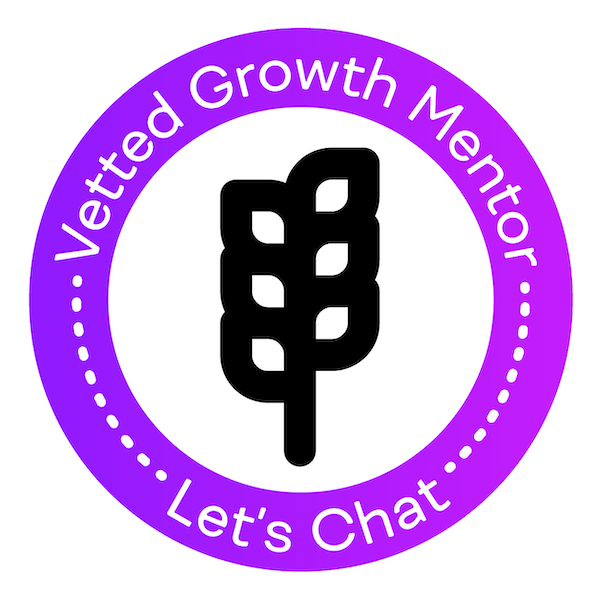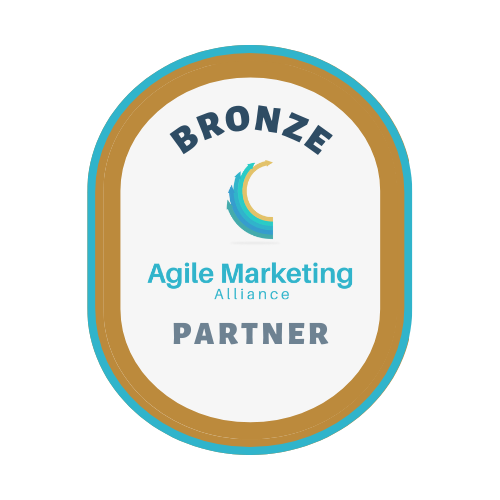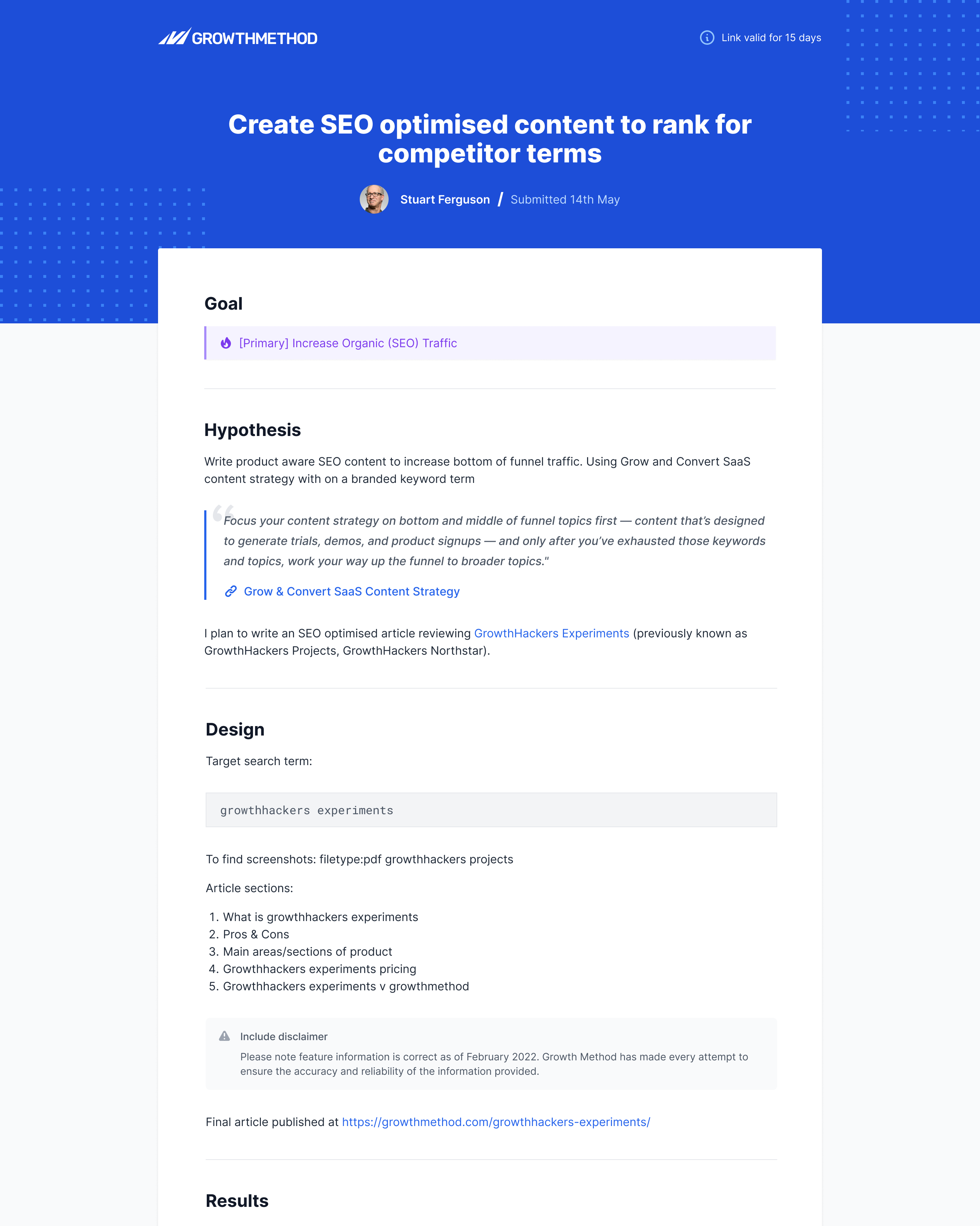20 customer acquisition channels for growth marketers
Article originally published in March 2022 by Stuart Brameld. Most recent update in April 2024.
Request a demo
Project management for growth and agile marketing professionals. Map your acquisition funnel, integrate analytics and run agile experiments.
Experiment results
Recent experiments results include competitor SEO, AI-driven content, exit-intent modals and AB testing homepage headlines.
Case study
"We are on-track to deliver a 43% increase in inbound leads this year. There is no doubt the adoption of Growth Method is the primary driver behind these results."
![]()
Certified
We are vetted mentors with Growth Mentor and a partner with the Agile Marketing Alliance.
Acquisition channels (also known as marketing channels or traction channels) are the means by which you acquire new prospects and customers.
A core focus of your growth marketing strategy should therefore be identifying the most successful marketing channel(s) for customer acquisition. You need to identify which channels allow you to profitably attract new clients in a way that has a measurable and significant impact on your business.
Being strategic with acquisition channels
Whilst your marketing activity may involve many different marketing channels, your customer acquisition is likely heavily skewed to one core channel.
Customer acquisition channels from the power law of distribution. Also commonly known as the Pareto principle (or 80-20 rule) this states that roughly 80% of your results in terms of customer acquisition likely come from 20% of your efforts.
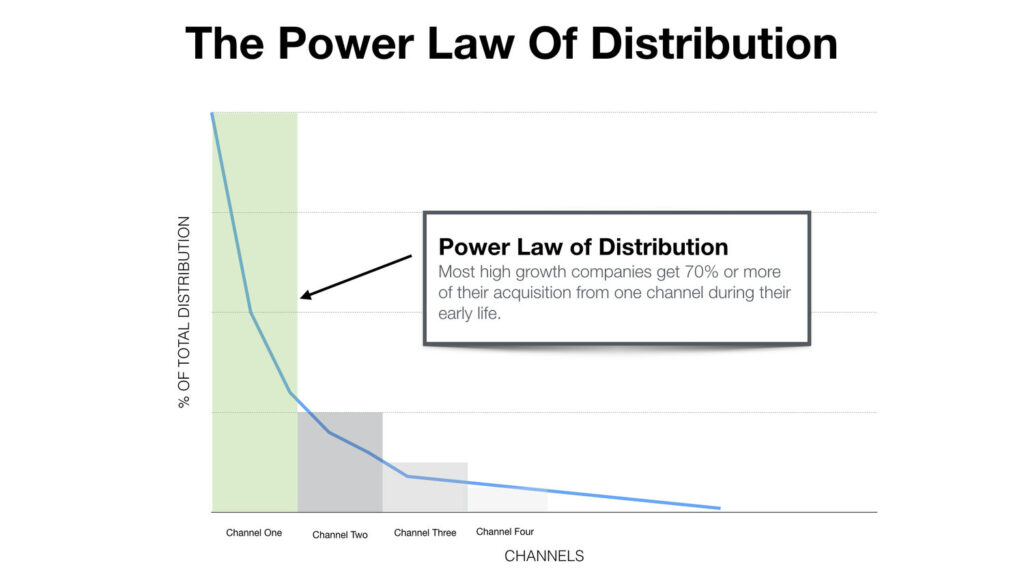
Don’t diversify yourself in too many channels; it’s like a death sentence. You should be focusing on the single and most efficient one.
Brian Balfour
How to evaluate marketing channels
Clearly, if 80% of the results come from 20% of the effort, choosing the best acquisition channel for your business is high-leverage activity.
Whilst there is no “right acquisition channel” for your business we have included a number questions below in order to help you narrow down the selection.
- Where is your ideal customer? Do they spend time in this channel?
- Input & output time – the upfront time required to start running experiments versus the time it takes to start getting data
- What is the cost of acquisition in the channel, and how does this compare to customer lifetime value? (known as your LTV:CAC ratio)
- Does the channel provide fast payback (like ads) or slow payback (like SEO)?
- How scalable is the channel, and does this matter at your current stage?
- Are you looking for a pull (capturing demand) or push (generating demand) approach? Are people actively searching for your solution(s)?
- Is this an online or offline channel?
- How mature is the channel? Can you compete, and win, in the channel?
- Control – the ability to turn the channel on or off at will
- Product/channel fit – is your product or service built to take advantage of a particular channel?
Acquisition channel testing
In the popular growth hacking book Traction, Gabriel Weinberg and Justin Mares describe 19 customer acquisition channels (they call them traction channels) that businesses can use to acquire new customers.
Rather than copying what competitors do, or acquiring customers in the same way you have in the past, the book goes on to describe an approach known as The Bullseye Framework to test these different channels and uncover what works for your specific business. Clearly, this is an excellent use-case for experimentation.
The 20 customer acquisition channels
According to the book, there are a total of 19 marketing channels that every business should consider and test. These are as follows, we delve into each one in-depth below.
- Targeting Blogs
- Public Relations
- Unconventional PR
- Search Engine Marketing
- Social & Display Ads
- Offline Ads
- Search Engine Optimisation
- Content Marketing
- Email Marketing
- Viral Marketing
- Engineering as Marketing
- Business Development
- Sales
- Affiliate Programs
- Existing Platforms
- Trade Shows
- Offline Events
- Speaking Engagements
- Community Building
- Conversion Rate Optimisation
Targeting Blogs
“Targeting blogs prospective customers read is one of the most effective ways to get your first wave of customers. Popular startups like Codecademy, Mint, and reddit all got their start by targeting blogs.
Gabriel Weinberg, Traction
Connect with relevant blogs in your industry in order to gain valuable exposure for your business and brand. These may include company blogs, industry blogs, niche news sites and content aggregation sites.
Blogs often want to write about new businesses and services that their readers may be interested in, some options for using blogs as one of your acquisition channels include:
- Offering to write an article for their audience
- Asking them to review your product or business for their readers
- If they don’t run adverts on the site, asking if you could test an ad with them
To increase your likelihood of success in this channel, always ensure you are offering value to both the owner of the blog and to their audience.
Noah Kagan famously used this strategy at Mint.com to help the company get more than 1 million users in six months.
Publicity / PR
“Publicity is the art of getting your name out there via traditional media outlets like news outlets, newspapers, magazines, TV and blogs. This can be getting featured in an industry magazine or a primetime TV appearance.
Gabriel Weinberg, Traction
The key is to provide something of value or interest to the audience of the reporter or journalist you are pitching to, for example:
- An exclusive on a piece of content, a study or some original research that leverages data only you have access to
- A free account, discounted access or affiliate revenue agreement in exchange for promoting your software or product
Whilst today’s media landscape is changing rapidly, news publications are still resource-constrained and looking for unique storytelling that will appeal to their readers. Make it an easy decision for them to work with you by being a source of great, compelling content. Remember the more compelling your story, the more page views, exposure and ad revenue for the media business.
“Either write something worth reading or do something worth writing about”
Benjamin Franklin
Links from mainstream news outlets carry a lot of weight, both in terms of brand awareness and referral traffic, but also in helping to increase your domain authority and keyword rankings in Google.
Unconventional PR
Unconventional PR is anything that is engineered to get media coverage, this includes publicity stunts, customer appreciation, gifts, contests and giveaways.
Gabriel Weinberg, Traction
Some examples of unconvential PR include:
- Shopify, the popular e-commerce platform, has an annual Build A Business competition. There is a $100,000 grand prize to the new online business launched on the Shopify platform that posts the highest grossing sales in a six month period.
- David Hauser, CEO of Grasshopper.com (now part of Citrix) has sent customers homemade cookies, Starbucks gift cards, books and handwritten notes. These activities have worked so well he now has 2 full-time employees whose sole responsibility is to delight customers.
- Richard Branson is famous for using publicity events and stunts to launch new lines of business at Virgin Group. He arrived in a spacesuit for Press Conference to launch Virgin Galactic.
- Blendtec used viral videos to increase the sales of its blenders many times over in their “Will it Blend?” videos. The “Will it Blend? – iPad” video alone received over 11 million views on YouTube.
Unconventional PR tests to consider:
- Host a contest around your product, such as a cash giveaway for creative usage. Use both paid and earned media to promote the contest.
- Create a video that you think could go viral with your audience, such as explaining how a large competitor do something poorly, and how you do it better
- Send existing customers homemade cookies or cupcakes to thank them for their business
Search Engine Marketing (SEM)
“Search engine marketing (SEM) refers to placing advertisments on search engines like Google and DuckDuckGo, where online marketers spend more than $100 million each day.
Gabriel Weinberg, Traction
Search engine marketing allows you to show advertisements next to relevant search queries on search engines such as Google, Bing and Yahoo. The main advantage of this marketing channel is being that your ad is direct response to the customer searching for something, which is a strong indicator of intent.
In order to test search engine marketing as one of your acquisition channels you could:
- Run 4 ads on Bing Ads for highly relevant keywords
- Run 4 ads on Google Ads for relevant competitor terms
Unlike other marketing channels such as Search Engine Optimisation, Paid advertising can be tested extremely quickly, in as little as 2 to 4 weeks, hence can be a great early launchpad. If you have the funds available, it can be equally quick to scale-up. It is not without problems though, paid channels often become saturated and more expensive over time, and the ease with which it can be copied introduces competition risk. Aim to understand the best-case conversion scenario and the cost of acquiring customers through this channel as quickly as possible.
Social & Display Advertising
“Display ads are the banner ads that you see on Web sites all over the Internet. Social ads are the ads on social sites, like those in our near your Facebook and Twitter timelines.
Gabriel Weinberg, Traction
The demographic and social information held by these platforms often means they can provide extremely granular ad targeting. These platforms also tend to be more cost effective than search engines such as Google. However, ads are generally not in response to search intent (as with SEM, above), but rather interrupting existing behaviour. As a result, you have to stand out and deliver a message that grabs someone’s attention.
In order to test social and display ads as one of the customer acquisition channels for your business, you could:
- Run a Facebook ad campaign targeting two niche audiences are likely to convert well. Be as specific as possible, leveraging competitors, demographics and interests. Test with a number of different ad images.
- Test podcast advertising, or some other more niche focused advertising option
- Advertise on 5 relevant blog sites
Offline Advertising
“Even today, advertisers spend more on offline ads than they do on online. There are many kinds of offline ads — TV, radio, magazines, newspapers, yellow pages, billboards, and direct mail. All of these can utilized at almost any scale, from local campaigns to national ones.”
Gabriel Weinberg, Traction
This type of advertising might not be for everyone, but can work well for certain industries and customer demographics. In some cases, offline advertising is so under-utilised, it provides a great opportunity to increase brand visibility with low competition.
Typically offline advertising still sees far less competition than online, and it remains an underused channel for acquiring customers.
To test offline advertising as a marketing channel you could:
- Place some ads in local papers
- Advertise on a niche podcast
- Purchase remnant advertising
- Purchase inexpensive remnant advertising through a broker
While it is definitely less precise in terms of targeting and arguably harder to measure ROI, offline ads might be the best option for getting in front of your ideal buyer. Offline ads offer you the opportunity to diversify your acquisition channels and can be used at any scale.
Search Engine Optimisation
“Almost all Internet users turn to search engines for answers. Search engine optimisation (SEO) is the process of improving your ranking in search engines in order to get more people to your site.”
Gabriel Weinberg, Traction
Almost all Internet users turn to search engines for answers. Search engine optimisation (SEO) is the process of improving your ranking in search engines in order to get more people to your site, typically done by creating good content that attracts customers and links.
To test offline advertising as a traction channel you could:
- Test a “long-tail” SEO strategy through creating content-rich pages. Perhaps your product can naturally produce data for these pages, or maybe you have enough data from making and researching your product. Link to these new pages right from your home page (e.g. in the footer), as this will help with ranking. Let relevant people know about your content and see if they’ll repost it with a link back to the original source.
- Test a “fat-head” SEO strategy by identifying promising fat-head keywords and running search engine ads to see how effective the traffic may be. This is a very similar basic test to Search Engine Marketing itself, though the keywords may be different.
Whilst SEO can deliver compounding results, it takes a long time (normally at least 6 months) to see results, particularly for early-stage companies. SEO is often used in combination with another marketing channel, such as content marketing, publicity, or unconventional PR. If your company has user-generated content that can be indexed by search engines, such as AirBNB or Pinterest, SEO engineering can be an incredibly effective customer acquisition channel.
Content Marketing
“If you invest in content, it gets picked up by Google. People find it, they share it, and it refers customers almost indefinitely.”
Rick Perreault, CEO, Unbounce
Content marketing is marketing that involves attracting customers by creating and sharing content that resonates with your target audience. This can take the form of text articles or blogs, case studies, how-to guides, question and answer articles, videos, audio, podcasts, images or photos.
To test content marketing as one of your acquisition channels you could:
- Start a company blog and write one blog post a week for a month. Promote your posts on Twitter and on link-sharing sites. If you see any significant audience growth and conversion, double down and commit to a few more months. Turn on comments for your posts and engage with any commenters. Try to write controversial or surprising posts, ideally using new data you’ve researched.
- Write a an article called “Our competitor vs Our Company” in order to attract search engine traffic looking for reviews of a competitors product. Promote your article on Twitter and on link-sharing sites.
- Offer free templates relating to the niche you offer in. Bidsketch use this to good effect by offering free proposal templates in exchange for an email address.
- Create an in-depth guide or book on a particular subject. The Intercom Product Management ebook is another great example here.
There are many examples of companies that have excelled in content, perhaps the best well-known being Red Bull. Red Bull is still most famous for its energy drink but content has become such a large part of the business that in 2007 they launched Red Bull Media House, as a totally separate division of the company. The goal is now for this media division to become a profitable enterprise in its own right
People want to earn more money, be better at their jobs, and know more about the industries they work in. With content marketing, you can provide free education to potential customers and build a valuable audience over time.
Email Marketing
Email marketing is one of the best ways to convert prospects while retaining and monetising existing customers. Email marketing is a personal channel. Messages from your company sit next to email updates from friends and family. As such, email marketing works best when it is personalised.
Gabriel Weinberg, Traction
By collecting email addresses of prospects or customers and engaging them with interesting content or great offers, you can stay top of mind and generate additional revenue.
“Email marketing is 40 times more effective than Facebook and Twitter combined as a way to acquire new customers”
McKinsey & Co
To test email marketing as a marketing channel you could:
- Create an automated email mini-course, where you teach something relevant to your product or service in bite-sized chunks. Make a landing page for the course and drive some traffic to it. At the end of the mini-course, encourage prospective customers to further investigate your product or service via an additional download, or sales consultation. Promote the course in your company e-mail signatures.
- Contact ten email newsletters in your niche and advertise on at least two of them where it makes sense financially. If they don’t usually run advertisements in their emails, ask to sponsor the list for a week or month.
Conversion rates from social media, particularly in b2b, and extremely low. Email marketing has the
best conversion rates. People buy stuff in droves over email. Building up an engaged and loyal email
list is a great way to grow your product and increase sales.
Viral marketing
“Viral marketing consists of growing your customer base by encouraging your customers to refer other customers, or getting your content, idea or story to spread. ‘Going viral’ means that every user you acquire brings in at least one other user. That new user then invites at least one other user, and so on. This creates true exponential growth.
Gabriel Weinberg, Traction
Though challenging to sustain, viral marketing has been the driving force behind many Silicon Valley success stories. Companies such as Hotmail, Dropbox, LinkedIn and Facebook all used customer invites and viral loops early on to encourage each new user to invite at least one more user after sign-up. The average number of users each new user refers is known as the viral coefficient. The goal with viral marketing and referral loops is to achieve a viral coefficient greater than one.
Today, for viral marketing to succeed, virality needs to be “baked in” to the product rather than added as afterthought.
To test email marketing as one of your acquisition channels you could:
- Implement a newsletter referral scheme using a product such as SparkLoop
- Build a viral loop into your product or service and measure your viral coefficient and viral cycle time. Measure which step is the weakest in your viral loop (signup percentage, number of invites, click-through percentage) and try to improve it.
Engineering as Marketing
“Your team’s engineering skills can get your startup traction directly by building tools and resources that reach more people. You make useful tools like calculators, widgets, and educational microsites to get your company in front of potential customers. These tools generate leads and expand your customer base.”
Gabriel Weinberg, Traction
Releasing free tools that help your customers to their jobs better is an excellent way to grow your business. These tools should be valuable, well-designed, and easy-to-use. Companies like Moz, Shopify, Crew, WPEngine (with their speed test tool) and HubSpot (with their Market Grader tool) have used their teams engineering skills to build tools to generate leads and expand their customer base. In 2019, HubSpot revealed that their Market Grade tool had been used to grade over 1 million websites.
Engineering as marketing to:
- Make a simple tool or side product that naturally leads to your product, ideally one that surfaces the problem and helps customers to recognise that they need you
- Create a live pricing or quoting tool calculator that provides prospects with an accurate price in exchange for key information an email address
- Create a simple free tool tangentially relevant to your company; for example, a maturity assessment tool. Put it on its own domain and name it something that people would search for. Collect contact information in exchange for using the tool. Reach out to anyone who uses your tool with a personal email about your main product.
Business Development & Partnerships
Business development (BD) is the process of creating strategic relationships that benefit both your company and your partner. It’s like sales with one key distinction: With sales, you’re selling directly to a customer. With business development, you’re partnering to reach customers in a way that benefits both parties.
Gabriel Weinberg, Traction
Look for partnership opportunities with people or companies with a similar size and focus to yours. Cross-promote each others brand and up-sell each other’s products. You can reach their network to reach more customers while you offer them value through your own audience and network. There are 5 different types of partnerships:
- Standard partnerships
- Joint ventures
- Licensing
- Distribution deals
- Supply partners
Google got its initial burst of traction by partnering with Yahoo to power their search engine. Delicious used a partnership with The Washington Post to increase its traffic and land lots of other key partners.
Test business development and partnerships by:
- Reaching out to 2 or 3 companies that have complementary products to yours in order to gauge interest in a partnership
- Contact consultants or integrators in your industry in order to gauge interest in them licensing and using your product
Sales
Sales is focused primarily on creating processes to directly exchange product for dollars. Sometimes hand-holding prospects can be necessary to turn them into real customers This involves creating a refined sales funnel that continually generates leads, qualifies them, and converts them into paying customers.
Gabriel Weinberg, Traction
Unlike most consumer products, many B2B products require sales process and team to close deals. In general, sales teams work best for products and services with long-term contracts and high lifetime value customers.
In order to test Sales as one of your marketing channels:
- Reach out over email to 100 prospective customers that could be a good fit for your business to request a call
- Install live chat on your site, or in your app, to discover if prospects require more in-depth advice around your product or service
- Add a a’request a consultation’ option to your website where customers can book a 20-minute walkthrough with a sales engineer or product expert
Affiliate Programs
An affiliate program is an arrangement where you pay people or companies for performing certain actions like making a sale or getting a qualified lead. Companies like Amazon, Zappos, eBay, Orbitz, and Netflix use affiliate programs to drive significant portions of their revenue. In fact, affiliate programs are the core traction channel for many e-commerce stores, information products, and membership programs.
Gabriel Weinberg, Traction
In a typical affiliate partnership, a third-party will drive traffic to your site and you pay a commission for every sale that results from this traffic. These programmes tend to work well for e-commerce products, information products and membership programs. With affiliate marketing, you could have an army of affiliates (content writers, bloggers and influencers) promoting your product in exchange for a cut of each sale. Affiliate marketing scales well as it isn’t a “pay to play” marketing channel, you only pay for each additional customer.
To test affiliate partnerships as one of your marketing acquisition channels consider:
- Register your product with a relevant affiliate network. Recruit twenty affiliates and use a simple yet attractive payout structure to gauge interest
- Contact existing customers you think might be well connected to prospective customers and strike affiliate deals with them.
Existing Platforms
Existing platforms are websites, apps, or networks with huge numbers of users — sometimes in the hundreds of millions — that you can potentially leverage to get traction. Major platforms include the Apple and Android App Stores, Mozilla and Chrome browser extensions, social platforms like Facebook, Twitter, and Pinterest, as well as newer platforms that are growing rapidly (Tumblr, Snapchat, etc.).
Gabriel Weinberg, Traction
Focusing on existing platforms means focusing your growth efforts on one of these megaplatforms, and getting some of their hundreds of millions of users to use your product. Once you know where your potential customers hang out you can figure out a way to reach them and get more exposure for your message and brand.
In order to test existing platforms as a marketing channel:
- Identify the most relevant niche platform where your audience hangs out online. Research the best practices for promoting products on that platform and then do so with your product. Try some paid tools or advertising if available for the platform.
- Make a simple browser extension, if relevant for your product or service.
Trade Shows
Trade shows offer you the opportunity to showcase your products in person. These events are often exclusive to industry insiders, and are designed to foster interactions between vendors and their prospects.
Gabriel Weinberg, Traction
Trade shows and events can be used to network, make announcements, sell to larger clients, build partnerships, and as an integral part of your sales process. You often do always need a stand or booth to be effective.
- List all relevant events over the next year. Dig deeper on the next few months to make sure smaller events are on your list. Exhibit at the one that seems most promising.
- Go to a relevant trade show as an attendee, connect with potential customers and prospects beforehand and arrange to meet for customer development.
Offline Events
Offline events give you the opportunity to engage directly with potential customers about their problems. Such events are especially important when your target customers do not respond well to online advertising and do not have a natural place to congregate online. Attracting these customers to one location or going to a place where they meet in person can be the most effective way to reach them.
Gabriel Weinberg, Traction
People love to attend conferences and get-togethers where they can network, learn, and have fun. HubSpot’s annual INBOUND conference brings 10,000 marketers together with HubSpot and its various products at the centre of it. Companies including Oracle, Salesforce and Box put on huge conferences in order to help maintain their position as market leaders. As the host of an offline event, your company has countless opportunities to grow its brand, talk with customers, and close key deals.
In order to test offline events at a small scale consider:
- Put together a one-day mini-conference and pull together a few regional guest speakers to speak during the day.
- Email prospects and customers in a local area and ask if they would be interested in a meet-up or evening social event to meet likeminded individuals.
- Sponsor a relevant meetup or conference (Product Hunt sponsor smaller meetups in cities all over the world)
Speaking Engagements
Public speaking can help increase the awareness of your business and establish an individual (and your business by extension) as experts in a particular field. This channel works well when there is a group of people in a room that — if you pitched them right — would move the needle for your business.
Gabriel Weinberg, Traction
Speaking at conferences and other live events can be a great way to build business relationships with future customers, partners, and friends. That said, these talks are unlike to lead to tangible results in the short term. Speaking at conferences is often a product of success, not a cause of it.
Test speaking engagement as a marketing channel by:
- Pitching to give a talk at a relevant regional conference
- Contacting 5 podcast hosts to discuss a topic where you have unique insight or expertise on their show
Community Building
Community building involves investing in the connections among your customers, fostering those relationships and helping them bring more people together. You can build this community on different platforms – via email, in the comments of your blog or face-to-face.
Gabriel Weinberg, Traction
Building a community around a business, brand or product can be an excellent strategy to help grow brand awareness and to acquire customers. In this sense, community building means investing in the connections among your customers, fostering those relationships and helping them to bring more people together.
Companies like Reddit, Stack Exchange, Hacker News and Product Hunt have grown by forming passionate communities at their core.
To explore community building as one of your core marketing channels you can:
- Join three online forums where your customers already exist and engage as a useful member of the community on at least twenty threads on each over the period of a month. Include references to your product where appropriate and in your signature.
- Start putting together your own community using an online forum tool.
Conversion rate optimisation (CRO)
Conversion rate optimisation is the process of getting more from existing traffic, often through experimentation such as AB testing. Whilst CRO isn’t an acquisition as such, the Growth Method team give it equal importance when it comes to getting the most from acquisition activities.
Acquisition channels in Growth Method
Marketing channels are a core part of Growth Method app functionality and are available in Ideas, Experiments, Playbooks and Reporting sections of the product.
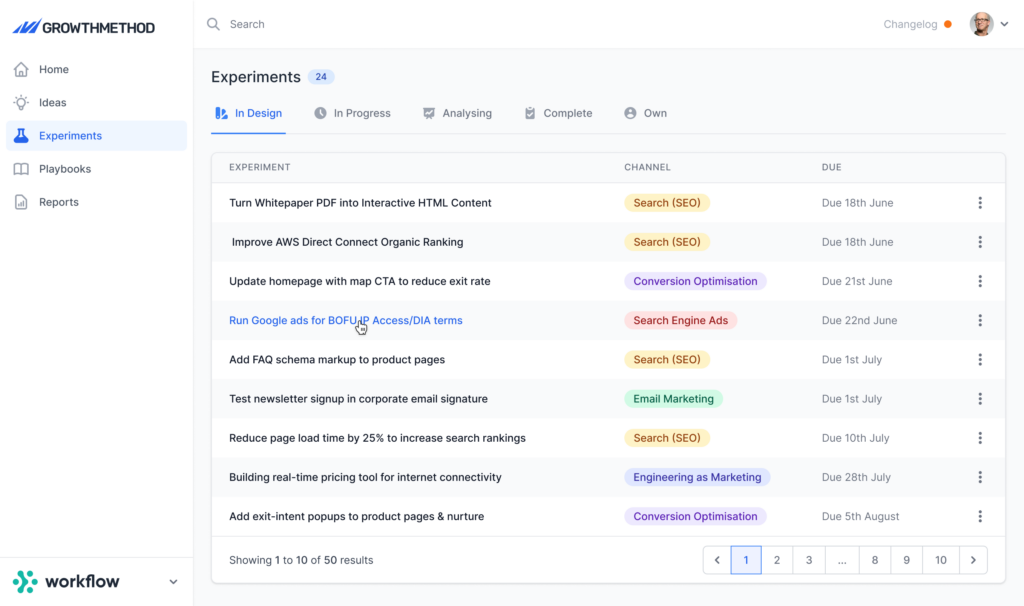
Whilst there is no enforced framework or approach within the app, this does allow you to sort and filter by channel, as well as utilise marketing channels in your reports – for example, to see which channels deliver the most successful experiments for your business.
Resources
Recommended additional reading.
Final thoughts
Think of distribution channels as pokemon characters. They each have a set of rules and a list of superpowers. You can’t change how that distribution channel behaves, the rules, or its superpowers.
Instead, find the distribution channels you can enslave with your product’s attributes, your team’s execution, or finding a blue ocean to grow within.
Kieran Flanagan, SVP Marketing, HubSpot
Got questions? Ping me on LinkedIn or on Twitter.
